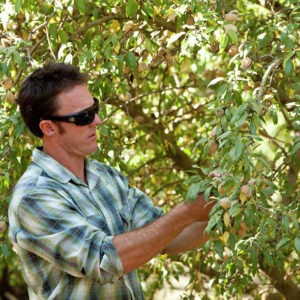(Photo: Almond Board of California)
BY STAS MARGARONIS
An association of U.S. agricultural exporters is asking the Biden administration to negotiate with ocean carriers to increase the number of loaded exports they pick up from U.S. ports so as to avoid major export losses in 2022.
“American almonds, dairy products, fresh produce and other agricultural communities have been unable to reliably ship sold product to buyers worldwide and can no longer bear the burden of the persistent ocean shipping obstacles,” according to an April 25th letter authored by an association of leading agricultural organizations.
The letter addressed to Agriculture Secretary Tom Vilsack, Transportation Secretary Pete Buttigieg and National Economic Council Director Brian Deese was signed by
- Jamie Johansson President California Farm Bureau Federation
- Dave Puglia President & CEO Western Growers
- Jim Mulhern President & CEO National Milk Producers Foundation
- Krysta Harden President & CEO U.S. Dairy Export Council
- Aubrey Bettencourt President/CEO Almond Alliance of California
- Anja Raudabaugh CEO Western United Dairies
- Don Barton California Walnut Handlers Coalition
The authors ask the Biden administration to directly intervene on their behalf with ocean carriers: “We need your continued leadership and ask that the administration act as the lead negotiator, convening a meeting with carriers to negotiate the following: 1. Make available the necessary number of containers and required equipment, and 2. Commit to adequate receiving windows (2-4 days).”
The letter said the crisis facing U.S. agricultural exporters is caused by obstacles that “included empty container and equipment shortages, broken export contracts and canceled bookings, and inadequate receiving windows by shipping carriers that have gone unaddressed for over a year.”
The agricultural leaders praised the efforts to set up pop up terminal facilities to facilitate shipments: “The effort to establish pop-up port terminal facilities in Oakland, Seattle, Savannah and elsewhere has also been constructive. However, despite these efforts, the problems our members face getting our goods to export markets have persisted and need further attention.”
The letter noted that “According to a recent University of California at Davis study, California agriculture lost $2.1 Billion in exports in a five-month period in 2021.”
The letter provided the following breakdown of losses faced on a commodity basis:
Almonds: “At the end of the 2021 crop year (July 2021), the carry out was 608.1 Million pounds. As of February 2022, U.S. Almond inventory was 2 Billion pounds. That is approximately 229% of last year’s carry out. … To meet that same carry out by the end of the 2022 crop year, we need to move 1.392 billion pounds of almonds across both domestic and export markets between now and July 31st. This will require approximately 31,000-34,000 containers … At this point last year 1.25 billion pounds had been exported from August 1st to February 1st. This year, only 993 million pounds have been exported. A difference of 258 million pounds. This is directly related to export shipments not getting loaded onto vessels.”
Stone Fruit: “For one notable stone fruit exporter, 95% of their supply goes through (the Port of) Oakland. The combination of eliminated ship calls and long delays on the remaining ones has forced them to pursue air freight – an extremely expensive option that will lead to a higher cost for the product. They are also looking to cut back on exports entirely, risking losing ground in established foreign markets.”
Dairy: “In 2021, supply chain challenges are estimated to have cost dairy exporters $1.5 billion due to higher direct costs, lost export sales and reduced value … Dairy exporters have reported losing long-term customers to other foreign producers due to an inability to reliably deliver product. A dairy export competitor noted that they are ‘getting additional milk powder business from China because shipping from New Zealand is more reliable than from the United States.’”
Walnuts: “Historically, exports of California walnuts during the first 7 months of a season (Sept. 1 to Mar. 31), should average 52% of the total crop. This year, export shipments are only 43% – a difference of 117 million pounds! – Which is directly related to supply chain issues preventing agricultural exports. … With continued challenges exporting walnuts, China (the #1 walnut producer) and Chile (the #3 walnut producer) have filled the gap eroding US market share as well as damaging the USA’s reputation as being a reliable supplier.”

